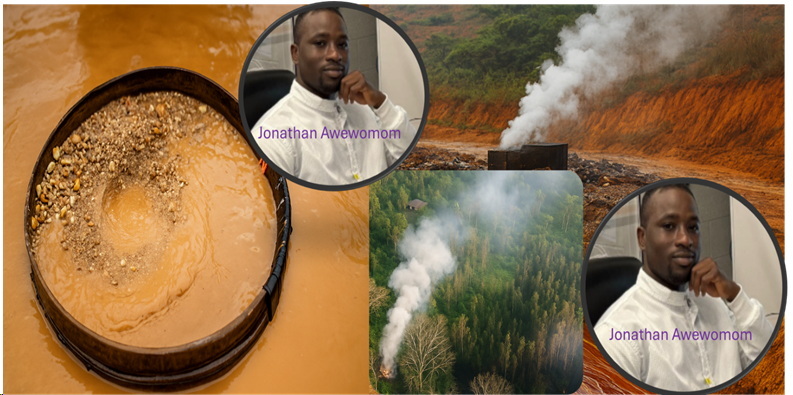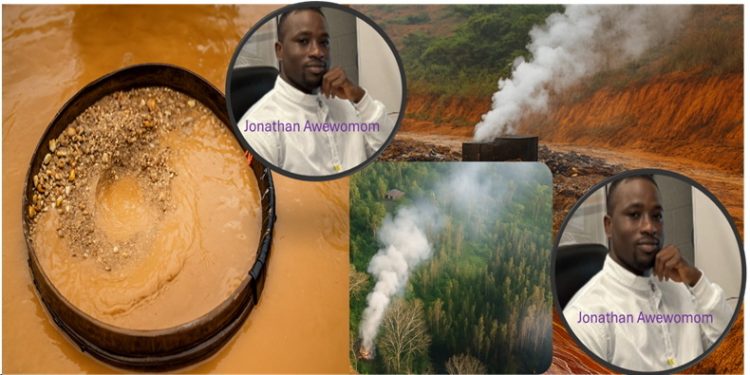
The Contaminant Legacy of Galamsey; Generated Pollutants
Galamsey is not only stripping Ghana’s forests and polluting its rivers but also leaving behind a chemical footprint that will haunt ecosystems and communities for decades. The pollutants released by these unregulated operations travel through air, water, and soil, seeping into the very lifelines of human existence. Their effects are both immediate and intergenerational, creating a cycle of exposure, disease, and social instability.
Sulfur Dioxide (SO₂)
SO₂ is generated during the combustion of diesel and crude oil used in galamsey machinery. Once released, it dissolves in atmospheric moisture to form sulfurous acid, contributing to respiratory irritation and acidification of local rainfall. Inhalation of SO₂ can cause bronchoconstriction, aggravate asthma, and increase cardiovascular strain, particularly in children and the elderly. Long-term exposure has been associated with congenital limb and neural tube defects in offspring of pregnant women exposed in mining zones. Its gaseous nature means SO₂ spreads beyond the immediate mining site, affecting entire communities downwind.
Carbon Monoxide (CO)
Carbon monoxide is emitted from engines running in poorly ventilated mining pits and camps. CO binds strongly to hemoglobin, reducing oxygen delivery to tissues and creating silent but deadly hypoxia. Chronic exposure is linked to low birth weight, small-for-gestational-age babies, and higher rates of asthma and neurodevelopmental disorders such as autism spectrum disorder. In the Ghanaian setting, where miners live close to operational sites, families, including pregnant women are continuously exposed, perpetuating cycles of poor health outcomes.
Nitrates (Ammonium Nitrate from Blasting)
Blasting with ammonium nitrate leaves nitrates that infiltrate streams and groundwater. Once ingested through drinking water, nitrates are converted to nitrites in the body, which can form carcinogenic N-nitroso compounds. Prenatal exposure is associated with preterm birth, neural tube defects, and congenital heart anomalies. Nitrate contamination is particularly concerning in rural galamsey regions where residents rely on untreated wells and boreholes, exposing entire communities, including infants, to chronic risks.
Silt
Siltation is perhaps the most visible footprint of galamsey. Excavation of riverbeds leads to massive sediment loads that choke Ghana’s rivers, turning them into brown, sluggish streams. This reduces water quality, blocks sunlight from penetrating aquatic ecosystems, and leads to fish kills and biodiversity loss. The suspended solids also carry adsorbed metals, extending contamination far downstream and increasing the risk of waterborne diseases such as diarrhea, cholera, and dysentery in nearby communities.
Soot (Particulate Matter)
Illegal gold processing often relies on open fires and crude combustion methods, releasing fine soot particles into the air. These particles penetrate deep into the lungs, causing chronic bronchitis, asthma attacks, and even coronary heart disease. Pregnant women exposed to soot are at higher risk of preterm birth and infants with low birth weight. In densely populated galamsey camps, soot mixes with other airborne pollutants, compounding respiratory illness burdens.
Hydrocarbons (PAHs, VOCs, Methane, Fuel Oil, Grease)
Spills and leaks from diesel, lubricants, and other petroleum products release hydrocarbons into soil and water. Polycyclic aromatic hydrocarbons (PAHs) and volatile organic compounds (VOCs) metabolize into toxic intermediates that damage DNA, increase cancer risk, and impair fetal growth. Methane emissions from waste rock and tailings also contribute to greenhouse gas buildup, further linking galamsey to climate impacts. These hydrocarbons persist in the environment, contaminating groundwater and accumulating in crops consumed by local populations.
Cyanide
Cyanide is one of the most infamous galamsey pollutants. It is used in leaching processes to extract gold, but spills from tailings ponds or poorly managed effluent flow quickly into rivers. Cyanide inhibits cytochrome c oxidase in mitochondria, halting cellular respiration and leading to acute poisoning, metabolic acidosis, and in severe cases, death. Chronic low-level exposure can cause neurological symptoms and thyroid dysfunction. Alarming reports of cyanide residues in yams and cassava in Kenyasi far above safe limits reveal how food chains are being compromised.
Mercury
Mercury is central to galamsey operations, where it is used for amalgamation. When released, mercury enters aquatic systems and is converted to methylmercury, a potent neurotoxin. Methylmercury bioaccumulates in fish, leading to human exposure through diet. In pregnant women, it crosses the placenta, damaging fetal brain development and causing neural tube defects, tremors, and cognitive impairment in children. Mercury persists for years in sediments, and paradoxically, exposure risk often peaks after mining stops as sediments resuspend and re-enter food webs.
Heavy Metals (Lead, Arsenic, Cadmium, Nickel)
Heavy metals released from tailings and disturbed soils are effectively permanent contaminants. Lead disrupts heme synthesis, causing anemia, cognitive delays, and hypertension. Arsenic causes skin lesions, respiratory problems, and cancers, while cadmium affects kidney function and bone health. These metals are not biodegradable and remain in soil for decades, exposing future generations through dust inhalation, crop uptake, and groundwater leaching.
Tomorrow’s Burden, Today’s Choices
What makes these contaminants most alarming is their silent persistence and the invisible debt they create for generations yet unborn. The smoke that rises from open fires today, the mercury bead that glistens in the miner’s pan, the silt that clouds our rivers, all of these leave behind a legacy that will shape the health, livelihoods, and opportunities of children decades from now. Galamsey is not just an environmental issue; it is an inheritance issue. Are we content to pass along poisoned rivers, infertile soils, and a heavier public health burden to the next generation? Or can we re-imagine a future where gold extraction does not come at the cost of our nation’s health and social fabric? The challenge is not to condemn, but to confront the reality that every particle of soot and every drop of cyanide in our rivers is writing a story that our grandchildren will have to read.
DISCLAIMER: The Views, Comments, Opinions, Contributions and Statements made by Readers and Contributors on this platform do not necessarily represent the views or policy of Multimedia Group Limited.
DISCLAIMER: The Views, Comments, Opinions, Contributions and Statements made by Readers and Contributors on this platform do not necessarily represent the views or policy of Multimedia Group Limited.
- President Commissions 36.5 Million Dollars Hospital In The Tain District
- You Will Not Go Free For Killing An Hard Working MP – Akufo-Addo To MP’s Killer
- I Will Lead You To Victory – Ato Forson Assures NDC Supporters
Visit Our Social Media for More




